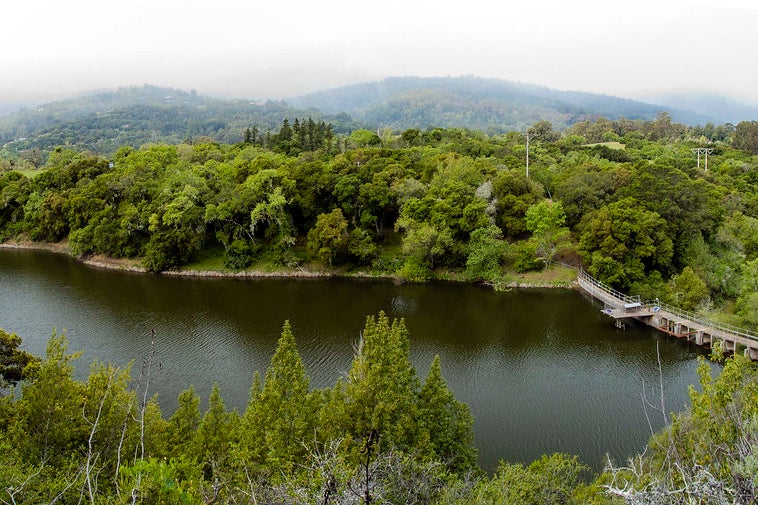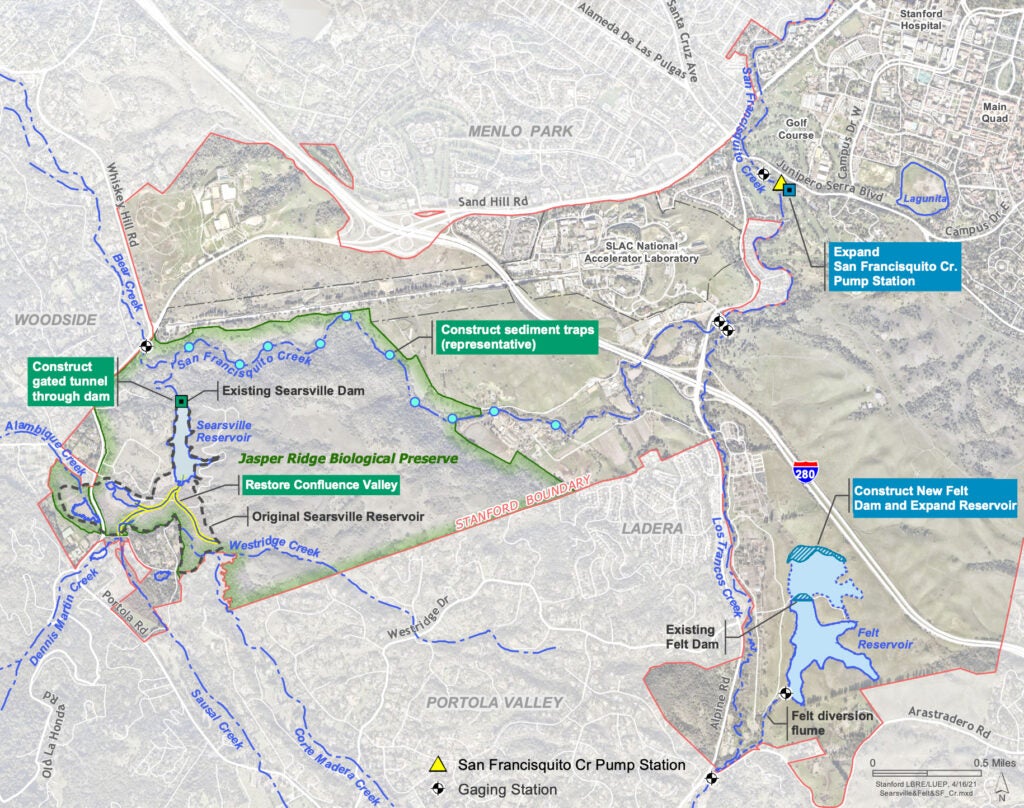Stanford proposes improvements to Searsville Dam and Reservoir
The Searsville Watershed Restoration Project will create a tunnel in the bottom of the dam, allowing for the gradual flushing of sediment downstream, enabling fish passage, and restoring native habitat conditions. The beginning of the environmental review process this month provides opportunities for community participation.
In the foothills above the Stanford campus, on university land within the Jasper Ridge Biological Preserve, lies the Searsville Reservoir and Dam.

Searsville Reservoir and Dam located within the Jasper Ridge Biological Preserve on Stanford land. (Image credit: Courtesy Land, Buildings, and Real Estate)
The dam was originally built in 1891 by the Spring Valley Water Company to provide drinking water for the region. However, the reservoir never proved to be a good source of drinking water due to the high concentration of sediment in the Corte Madera Creek that feeds the reservoir. Searsville was acquired by Stanford in 1919 to provide irrigation water for the campus, and it became a popular recreational destination for local residents until the mid-1970s when the biological preserve was established.
In more recent years, Searsville has posed a difficult challenge: How to address 132 years of gradually accumulating sediment that now fills 90 percent of the reservoir’s capacity?
After years of careful study and extensive public outreach, Stanford has developed a unique solution that will restore natural water and sediment flows without increasing downstream flood risks. The project will also enable fish passage and restore the native habitat above the dam.
The Searsville Watershed Restoration Project (SWRP) will construct a tunnel and gate at the base of Searsville Dam that will allow sediment to be gradually and safely flushed to San Francisquito Creek and ultimately to the bay, restoring the natural sediment process which will enhance natural marsh building along the shoreline. This process will be initiated after downstream projects to improve San Francisquito Creek’s channel capacity, which are being managed by the San Francisquito Creek Joint Power Authority, are completed.
Once permits are received, the tunnel and associated work are expected to take two years to construct. Flushing of the accumulated sediment will occur over a period of several years, depending on the magnitude and frequency of rainfall and resulting flow in the creeks above the dam, which will mobilize and transport the sediment downstream.
The final stage of the project – reestablishing fish passage conditions, creating the upstream confluence valley, and restoring the channel – would follow and take another year or two. The opening of the tunnel and restoration of the water flow will also allow for fish passage upstream and encourage biodiversity in the watershed.

The locations of the Searsville Watershed Restoration Project components. Click to enlarge. (Image credit: Courtesy Land, Buildings, and Real Estate)
The tunnel opening will be large enough to allow normal water flows but will constrict high storm flows, thus lessening the peak flow rate downstream and assisting with reducing downstream flooding. According to the project website: “Areas above Searsville Dam will be restored and managed to create a highly functioning confluence valley with riparian areas, meandering creeks, floodplain terraces, and wetland areas supporting a variety of habitats and vegetation.”
The project also includes the installation of habitat features in San Francisquito Creek. These habitat features will also provide opportunities for coarse sediment deposition and support and enhance creek health.
Stanford is concurrently studying two complementary project components – upgrades to the San Francisquito Creek Pump Station and construction of a new Felt Dam and expanded reservoir that would accommodate increased water storage, replacing that which will be lost at Searsville. The Felt Dam project includes a seismic upgrade to bring it in line with current design standards. Until the upgrade is completed, Stanford is proactively operating Felt Dam at a reduced capacity to minimize downstream flooding risk.
“After a thorough process of evaluating all of the issues at Searsville and options for their resolution, we’ve come up with an innovative plan that resolves the challenges posed by so much accumulated sediment and establishes a more ecologically sustainable future for Searsville,” said Tom Zigterman, senior director of water resources and civil infrastructure. “This project advances the university’s priorities of being a responsible neighbor and steward of our land and water resources and of fostering opportunities for learning and discovery with the restoration of this confluence valley.”
Planning for Searsville’s future
SWRP is the result of a process that began in 2011 when then-Provost John Etchemendy formed a steering committee comprised of faculty and university administrators to conduct the Searsville Alternatives Study. A related advisory group that included 27 representatives from resource and local agencies, stakeholder organizations, Jasper Ridge Biological Preserve (JRBP) docents, and local residents was created two years later.
The goals for the study reflected the ecological and academic importance of Searsville and included protecting and enhancing the teaching and research at JRBP; contributing to the long-term sustainability of the university’s water supply; supporting and enhancing the ecological health of San Francisquito Creek; not increasing (and decreasing, if possible) flood risk; and preserving important cultural resources. An important part of meeting these goals was addressing the accumulated sediment and future sediment load.
Three key recommendations emerged from the study and informed the project now being proposed by Stanford:
- Achieve fish passage while preserving and providing riparian and wetlands habitats and avoiding an increase in flooding.
- Restore the natural sediment process whereby sediment flows downstream.
- Create a replacement water diversion downstream and relocate the Searsville storage functions to an expanded Felt Reservoir.
Academic opportunities and cultural resource preservation
The benefits of SWRP will extend well beyond the removal of so much sediment and restoration of natural water flows.
Searsville’s location within JRBP means the project will provide many years of new multidisciplinary research and educational opportunities that can benefit from the robust baseline data that already exist. SWRP would be the only dam project undertaken by a university, and the dam’s urban reach is also unique.
“Consistent with Jasper Ridge’s mission, this project has the potential to not only advance our understanding of the local habitat but also how similar projects can implement socio-ecological restoration practices in watershed systems elsewhere in the world,” said Jorge Ramos, executive director of JRBP. “SWRP also provides our students and local communities a front-row seat in learning about restoration as it happens right here.”
The project area also contains many important archaeological sites, and Stanford archaeologists have been closely involved in the project design. The proposed project minimizes the impact on Native American cultural sites, and there is ongoing consultation with tribal groups.
The path forward and upcoming public meetings
Stanford is formally starting the state and federal environmental review processes for the Searsville Watershed Restoration Project this month. The environmental review process is being conducted by the California Department of Water Resources and the United States Army Corps of Engineers.
Interested parties are encouraged to engage in the process, and comments on the state Notice of Preparation (NOP) and federal Notice of Intent (NOI) for the environmental impact report are currently being accepted. Comments can be submitted anytime during the NOP/NOI review period, which ends on March 9, 2023, for the NOI and at 5 p.m. on March 17, 2023, for the NOP. All comments on the two documents will be aggregated. Two virtual public scoping meetings will be held on Tuesday, Feb. 28, from 3 to 4:30 p.m. and 6 to 7:30 p.m.
More information about the project is available at searsville.stanford.edu.